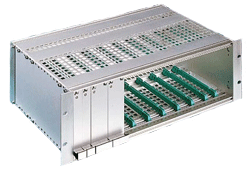Eurocard is a standard format for Printed Circuit Boards, which can be plugged together into a standardized subrack. The subrack consists of a series of slotted card guides on the top and bottom, into which the cards are slid so they stand on end, like books on a shelf. At the “back” of each card is one or more connectors, which plug into mating connectors on a backplane which closes the rear of the subrack.

Eurocard Subrack Chassis
The Eurocard format is in widespread use in many industries, including factory equipment, industrial controls, computer/datacom, telecom, and defense/military.
Eurocard subracks have standardized sizes in all three dimensions. Height is specified by the unit ‘U’ (which stands for ‘Unit’), with 1 U being 1.75 inches. The standard allows for a vast number of permutations, but in practice there are only comparatively few sizes in use. Heights are commonly 3U or 6U. The 160 mm depth is the most common today, followed by 220mm. Single size eurocard (3U) is 100mm x 160mm and double size eurocard (6U) is 233.4mm x 160mm.
The Eurocard mechanical architecture was defined originally under IEC-60297-3. Today, the most widely recognized standards for this mechanical structure are IEEE 1101.1, IEEE 1101.10 (also known commonly as “dot ten”) and IEEE 1101.11.
The Eurocard is a mechanical system and does not define the specific connector to be used or the signals that are assigned to connector contacts. The connector systems that are commonly used with Eurocard architectures include the original DIN 41612 connector that is also standardized as IEC 60603.2
